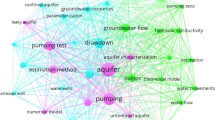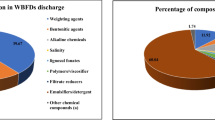Abstract
Enhanced understanding of light non-aqueous phase liquid (LNAPL) infiltration into sandy porous medium is significant to the effective design of remediation strategies. A system for buried pipeline leakage in 2-D sandbox was conducted to investigate the migration of diesel through a sandy porous medium, and the system could also be conducted to investigate groundwater remediation. Two groups of experiments were carried out. The first experiment consisted of diesel infiltration into a fine sand matrix. We could notice that diesel spilled in dry sand layer at a constant speed and the diesel front kept longitudinal movement due to the gravity before it arrived at the edge of the capillary zone. The diesel front broadened as a whole because of the capillary force jacking after it reached the capillary zone. Finally, the bulk of the diesel was contained on top of the capillary zone. To protect groundwater, the second experiment consisted of remediating soils and groundwater. The results indicated that the voltage of electrocoagulation apparatus had a great influence on the treatment effect, and the removal rate of diesel was found to be more than 90% with a constant voltage of 20 V. The efficiency of groundwater remediation was influenced by the flow velocity, and it took 11 h when the flow velocity was 2.089 L/min. To summarize, the research was conducive to the study on diesel pollution control and pollution prediction.










Similar content being viewed by others
References
Abdul AS (1988) Migration of petroleum products through sandy hydrogeologic systems. Groundwater Monit Remed 8:73–81
Asselin M, Drogui P, Benmoussa H, Blais JF (2008) Effectiveness of electrocoagulation process in removing organic compounds from slaughterhouse wastewater using monopolar and bipolar electrolytic cells. Chemosphere 72(11):1727–1733
Burns SE, Yiacoumi S, Tsouris C (1997) Microbubble generation for environmental and industrial separations. Sep Purif Technol 11(3):221–232
Cary JW, Simmons CS, Mcbride JF (1989) Predicting oil infiltration and redistribution in unsaturated soils. Soil Sci Soc Am J 53:335–342
Cary JW, Simmons CS, Mcbride JF (1994) Infiltration and redistribution of organic liquids in layered porous media. Soil Sci Soc Am J 58:704–711
Cañizares P, Jiménez C, Martínez F, Cristina Sáez A, Rodrigo MA (2007) Study of the electrocoagulation process using aluminum and iron electrodes. Ind Eng Chem Res 46(19):6189–6195
Duan J, Gregory J (2003) Coagulation by hydrolyzing metal salts. Adv Colloid Interf Sci:100–102
Eckberg DK, Sunada DK (1984) Nonsteady three-phase immiscible fluid distribution in porous media. Water Resour Res 20:1891–1897
Fine P, Yaron B (1993) Outdoor experiments on enhanced volatilization by venting of kerosene component from soil. J Contam Hydrol 12(4):355–374
Guo ZR, Zhang G, Fang J, Dou X (2006) Enhanced chromium recovery from tanning wastewater. J Clean Prod 14(1):75–79
Han WL, Lin Z (2009) Current situation and prospect of anti-corrosion technology for buried pipelines. Welded Pipe And Tube 31:9–13
He XQ (2011) Research progress of electrocoagulation in water treatment. Sichuan Environment 30:94–98
Holt PK, Barton GW, Wark M, Mitchell CA (2002) A quantitative comparison between chemical dosing and electrocoagulation. Colloids Surfaces A Physicochem Eng Aspects 211(2):233–248
Jiang WM, Chen MC, Yang J, Deng ZF, Liu Y, Bian J (2017) Dynamic experimental study of a new electrocoagulation apparatus with settlement scheme for the removal process in oilfield. J Electroanal Chem 801:14–21
Kechavarzi C, Soga K, Illangasekare TH (2005) Two-dimensional laboratory simulation of LNAPL infiltration and redistribution in the vadose zone. J Contam Hydrol 76:211–233
Li N, Zeng JH, Chen G (2008) Simulated study on the migration process and effects of diesel oil on the soil properties. J Saf Environ 8:1–6
Liu HL, Zhou QY, Wu HQ (2008) Determination of saturation distribution of light non-aqueous phase liquid based on electric resistivity tomography. J Hydraul Eng 39:189–195
Liu Y, Wang ZS, Yang J, Jiang WM, Chen MC (2017) Study on the factors affecting the stability of water emulsion emulsion. Appl Chem Industry 46:1266–1269
Lenhard RJ, Parker JC (1987) Measurement and prediction of saturation-pressure relationships in three-phase porous media systems. J Contam Hydrol 1(4):407–424
Li, J. (1999). Determination of oil content in soil by ultravioletvisible spectrophotometric method and supersonic extraction. J Univ Petroleum China
Pantazidou M, Sitar N (1993) Emplacement of nonaqueous liquids in the vadose zone. Water Resour Res 29(3):705–722
Pu M (2017) Study on extraction and treatment of groundwater in contaminated sites. Environ Eng 35:6–10
Schroth MH, Istok JD, Selker JS, White MD (1998a) Multifluid flow in bedded porous media: laboratory experiments and numerical simulations. Adv Water Resour 22:169–183
Schroth MH, Istok JD, Selker JS (1998b) Three-phase immiscible fluid movement in the vicinity of textural interfaces. J Contam Hydrol 32(1–2):1–23
Wang Y, Shao M (2009) Infiltration characteristics of non-aqueous phase liquids in undisturbed loessal soil cores. J Environ Sci 21:1424–1431
Wipfler EL, Ness M, Breedveld GD (2004) Infiltration and redistribution of LNAPL into unsaturated layered porous media. J Contam Hydrol 71(1):47–66
Waddill DW, Parker JC (1997) Recovery of light, non-aqueous phase liquid from porous media: laboratory experiments and model validation. J Contam Hydrol 27(1):127–155
Wu, X. F. (1996). Study on transport law of light non-aqueous liquid in unsaturated zone and saturated zone. Doctoral thesis of Tsinghua University
Wu XF, Tang J, Jiu TJX (1999) Capillary pressure and relative permeability in three phase flow of porous media. Prog Environ Sci 7:68–73
Wu YQ (2012) Mathematical model of porous media seepage and pollutant migration. Science Press
Wu XF, Tang J, Jiu TJX (2000) Study of light organic pollutants (LNAPL) lens in groundwater. Environ Poll Prev 22:17–20
Yang J, Liu Y, Chen MC, Deng ZF, Jiang WM, Chen YM, Wang ZS (2017) Experimental study on the purification of oily wastewater by a new type of electric flocculation apparatus. Indust Water Treatment 37:30–33
Yan LX, Fei SP, Zhi SD, Lei DC, Li WP, Li LY (2006) Transferring simulation of petroleum pollutants in soils of Daqing area. J China Univ Petrol 30(2):120–124
Yongxia LI, Zheng X, Yanfei MA (2011) Experimental study on the infiltration of diesel through unsaturated zone of soil. Environ Poll Control 33(5):27–31
Zheng DF, Zhao YS, Wang BD (2002) Light transport characteristics and simulation prediction of nonaqueous phase liquids in the underground environment. Progress in Water Sci 13:321–325
Zhang WJ, Dong WH, Su XS, Liu FT (2006) Comprehensive evaluation of remediation technology for groundwater pollution. Water Res Protection 22:1–4
Zhang Y. (2009). Study on treatment of oil recovery sewage by DC electrocoagulation method. Military Medical Science Academy of the PLA of Health and Environmental Medicine Research, 9–10.
Funding
This study was supported by the National Natural Science Foundation of China (Grant No. 51406240), the Natural Science Foundation of Shandong Province (Grant No. ZR2014EEQ003), the Qingdao Source Innovation Plan Application Basic Research Project (Grant No. 17-1-1-88-jch), and the Fundamental Research Funds for the Central Universities (Grant No. 18CX02082A, No. 12CX04070A, No.14CX02211A, and No.17CX02064).
Author information
Authors and Affiliations
Corresponding author
Additional information
Responsible editor: Philippe Garrigues
Highlights
1. The continuous system for buried pipeline leakage and rapid groundwater remediation was designed independently.
2. The pipe leaks inside the soil in the two-dimensional experimental facility, which was more close to the real buried pipeline leakage.
3. The electrocoagulation was applied to sewage disposal system of pump-treat technology to improve the efficiency of groundwater treatment.
Rights and permissions
About this article
Cite this article
Jiang, W., Yang, J., Zhu, J. et al. Experimental study on the transport characteristics of buried pipeline leakage and the performance of groundwater remediation system. Environ Sci Pollut Res 25, 36570–36580 (2018). https://doi.org/10.1007/s11356-018-3490-0
Received:
Accepted:
Published:
Issue Date:
DOI: https://doi.org/10.1007/s11356-018-3490-0




